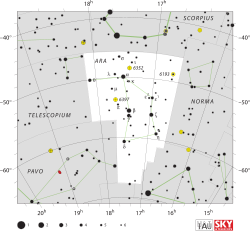Ara (constellation)
Ara is a constellation in the southern sky. Ara means altar in Latin. It was one of the 48 constellations written down by the astronomer named Ptolemy in the 2nd century. It is also one of the 88 modern constellations that were made by the International Astronomical Union.[1]
| Constellation | |
 | |
| Abbreviation | Arae |
|---|---|
| Genitive | Apodis |
| Pronunciation | /ˈɛərə/, genitive /ˈɛəriː/ |
| Symbolism | the Altar |
| Right ascension | 17.39 |
| Declination | −53.58 |
| Quadrant | SQ3 |
| Area | 237 sq. deg. (63rd) |
| Main stars | 8 |
| Bayer/Flamsteed stars | 17 |
| Stars with planets | 7 |
| Stars brighter than 3.00m | 2 |
| Stars within 10.00 pc (32.62 ly) | 3 |
| Brightest star | β Ara (2.84m) |
| Messier objects | None |
| Meteor showers | None |
| Bordering constellations | |
| Visible at latitudes between +25° and −90°. Best visible at 21:00 (9 p.m.) during the month of July. | |

In Greek mythology, Ara is the altar where Zeus and his brothers and sisters said that they were going to win in a war against Cronos and the other Titans.[2] It is also where people burned incense to show that they appreciated Zeus.[3] The Greek poet named Aratus said that if sailors could see the constellation Ara, it meant that there was going to be wind blowing from the south.
The Stingray Nebula is in Ara. It is the planetary nebula that was created most recently.[4]
NGC 6193 is an open cluster at about 3,765 light-years away from Earth.
References
change- ↑ "ARA". Harvard. Retrieved 27 January 2013.
- ↑ Ridpath, Ian. "Ara: The Altar". Star Tales. Retrieved 28 January 2013.
- ↑ "Ara". Peoria Astronomical Society. Archived from the original on 19 November 2012. Retrieved 28 January 2013.
- ↑ "Stingray Nebula". Image of the Day Gallery. NASA. 23 March 2008. Retrieved 28 January 2013.